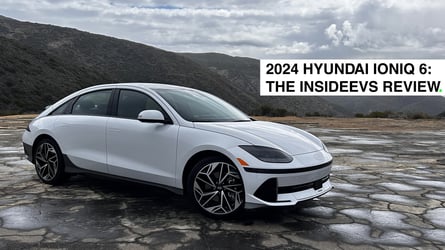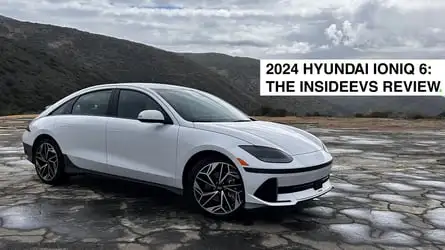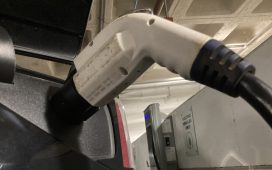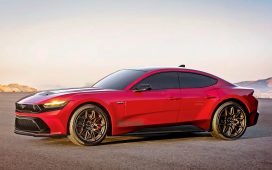It’s got class-leading range, industry-leading charging performance, excellent driving dynamics and a hell of a price. I’d buy one over any other EV sedan.


May 2, 2024 at 12:25pm ET
Hyundai was the first company to offer a mass-market, 800-volt electric car in America. Higher-voltage architectures are more efficient and charge far quicker than 400-volt systems. The payoff was clear with the Ioniq 5, a handsome, efficient long-range electric SUV. But in the Ioniq 6 sedan, that world-class architecture provides even more dramatic advantages. The Hyundai Ioniq 6 chargest faster than its competitors, goes farther, drives better and often costs less than they do.
It’s my favorite EV on sale, and if you’re in the market for an electric sedan, I highly recommend you just buy one.
Gallery: 2024 Hyundai Ioniq 6 Limited AWD Review
19 Photos
(Full Disclosure: Hyundai dropped off a fully charged Ioniq 6 SE Long Range RWD for my review. When a Honda Fit rear-ended it before I could finish the review, Hyundai provided an Ioniq 6 Limited AWD for my evaluation. This review covers both cars.)
Driving Experience
Hyundai Motor Group’s entire vehicle ride and handling development process was reshaped by a gentleman named Albert Biermann during his tenure as head of R&D. As the former boss of BMW M, Biermann knew a lot about how to make a good driver’s car. That’s obviously apparent in Hyundai’s spectacular line of N models, but the technical know-how he instilled has trickled down to everyday cars like the Ioniq 6.
I sampled both the Ioniq 6 SE Long Range RWD and the Ioniq 6 Limited AWD. Both exhibited great handling, a composed ride and excellent body control. If you like to drive, though, the RWD Ioniq 6 is a joyful, surprisingly tail-happy car with excellent steering.
Disable traction control and the 225-hp EV will slide as easily as an M5, with a playful attitude that makes it fun at street-legal speeds. The added power of the 320-hp AWD Ioniq 6 may be nice for some, but the RWD Long Range is plenty quick for everyday driving and far cheaper.
Just don’t opt for the Standard Range Ioniq 6. It puts down just 149 hp, which seems a bit low for a car that weighs around 3,400 lbs (The Long Range models weigh between 4,200 and 4,600 lbs).
The car’s excellent chassis tuning impresses in daily driving, too. The Ioniq 6 is a more comfortable daily than the last Tesla Model 3 I drove—though I haven’t yet sampled a post-refresh car—and plenty quiet. The only weak point is the seats, which on the SE Long Range proved uncomfortable even on medium-length trips. The Limited’s seats were much better.
One-pedal driving worked well in either car, but unfortunately, Hyundai makes you toggle the level you want with the shift paddles every time you start the car. There’s no way to boot into one-pedal mode. That’s the sort of annoying, one-extra-step process that leads people to Tesla’s more seamless software integration. I hope Hyundai addresses it. If you don’t like one-pedal driving, you can set the regen level to a lower level using the paddles. And as long as it’s not one-pedal mode (i-Pedal in Hyundai parlance), the car will remember your setting on startup.
Range, Battery Size, Observed Efficiency
The Hyundai Ioniq 6 is offered in three basic configurations: Standard Range, Long Range RWD, and Long Range AWD. Note that Hyundai does not use “Long Range” in the name—merely SE Standard Range and SE—but we use it for clarity. Long Range cars are offered with either 18- or 20-inch wheels, which seem to dramatically affect the range.
Here are the EPA-cycle range estimates for all trims:
| Trim | Range |
| Ioniq 6 SE Short Range | 240 Miles |
| Ioniq 6 SE Long Range RWD | 361 Miles |
| Ioniq 6 SE Long Range AWD | 316 Miles |
| Ioniq 6 SEL & Limited Long Range RWD* | 305 Miles |
| Ioniq 6 SEL & Limited Long Range AWD* | 270 Miles |
*These trims come standard with 20-inch wheels that sap range.
The 361-mile range for the SE Long Range RWD model is best in class, as Tesla only offers the RWD model 3 with a short-range battery pack. However, if you need AWD, note that the Model 3 offers more dual-motor endurance than the Hyundai: 341 miles in the Model 3 LR AWD compared to 316 miles for the Ioniq 6 LR AWD.
Unfortunately, a Honda Fit rear-ending me in traffic cut my time in the RWD Ioniq 6 short. (Thankfully, I was completely unhurt, which perhaps also speaks to its build quality and safety features too.) I couldn’t get a proper observed efficiency number. In the Limited AWD Ioniq 6, I averaged 3.1 mi/kWh over a 100-mile mostly-highway drive route that includes 5,000 ft of elevation gain and 5-10 miles of aggressive canyon driving. That’s an impressive efficiency, especially given that I drove through 20 minutes of snow at one point.
Based on the Ioniq 6’s 77.4-kWh battery size and my efficiency figure, the real-world driving range should be around 240 miles in those conditions. That’s short of the 270-mile estimate, but that’s an EPA combined figure with gentle driving. My mostly highway route combined with some, ahem, spirited driving tends to push cars below their estimates.
Charging Experience
I also did not sweat efficiency because I knew charging would be no problem. The Ioniq 6 can go from a 10 to 80% charge in just 18 minutes on a 350-kW DC fast charger, which beats pretty much everything on sale in the U.S. right now except the revised Porsche Taycan. It also supports battery preconditioning to get you closer to those optimal charging rates.
I did not do a full 10-80 test on a 350 kW charger. I charged from 46% to 81% in 25 minutes on a 150 kW charger. The Ioniq 6 took in 29.6 kW in this time, which based on my observed efficiency should be good for 91.76 miles of highway and canyon driving. That’s still plenty quick, but we know for a fact that these cars can deliver real-world 10-80% charge times under 20 minutes. That’s faster than any competitor.
Charging to 80% on a Level 2 plug takes six 6 hours 55 minutes, per Hyundai, though the company doesn’t specify whether that’s from 0 or 10%.
Interior
Electric vehicles are more expensive to build than internal-combustion vehicles right now, so manufacturers minimize the sale price difference by cutting costs inside the cars. That’s why Teslas have such minimalist interiors, and that’s why the Ioniq 6 is simpler inside than some of the internal-combustion Hyundais.
Generally, Hyundai does a good job of making it still look and feel good inside. The Ioniq 6 has a pleasing cabin design and decent materials, with physical controls for key functions. Yet much of what appears to be metal is plastic, and the touch-sensitive climate controls aren’t great. The cloth seats in the Ioniq 6 SE feel cheap and aren’t particularly comfortable, too; they’re less “high-tech electric flagship” and more “Hyundai you rented at the airport when you fly to Minneapolis for a wedding.” And while it’s a minor thing, the lack of an auto-dimming rear mirror on the $43,600 SE RWD makes it feel like you’re being nickel-and-dimed. It does not appear as a standalone option on the configurator, so if you don’t want to be blinded by trucks behind you you’ll have to either swap it yourself or shell out for the less-efficient SEL.
It’s also worth noting that the Ioniq 6 is not a great car for shuttling four tall adults. There’s plenty of legroom in the second row—a luxurious amount, really—but the aero-friendly tapered roofline of the Ioniq 6 cuts into rear-seat headroom. At 5’ 6” I was fine, but a 6’ 2” friend was hitting his head.
Tech Features
Hyundai offers a wide array of tech features on the Ioniq 6. The vehicle can remotely forward or backward into a parking spot using buttons on a key, for instance. It offers a full suite of active safety features, 360-degree cameras, interior LED lighting, Apple CarPlay, Android Auto and a Bose sound system.
One of its most notable features is its Vehicle-to-load (V2L) capability. The Ioniq 6 can export up to 3.6 kW of power through an adapter plugged into its charge port, which should be enough to power a variety of power tools, charge a scooter or other electric device and run your whole campsite. It also should support Vehicle-to-Home (V2H) capability eventually, but the setup to make that work isn’t on sale yet.
Infotainment & UX
The Hyundai Ioniq 6 offers a 12.3-inch digital gauge cluster and a 12.3-inch main infotainment display, running Hyundai’s familiar and relatively intuitive touch-based infotainment software. Most functions are relatively easy to accomplish once you get the hang of it, but it’s neither as fast nor as polished as software in cars like the Tesla Model 3.
There is a volume knob and a tuning switch, along with a custom physical button that can be mapped to an infotainment function. Hyundai also supports remote cabin conditioning, vehicle lock and unlock, tracking, maintenance planning and more in the MyHyundai app. Like with the infotainment software, the app is both better than the industry average and still far behind industry leaders like Tesla and Rivian.
Unlike those companies, though, Hyundai supports Apple CarPlay and Android Auto. Hyundai says over-the-air updates should add functionality over time, too.
Safety & ADAS
The Hyundai Ioniq 6 is an Insurance Institute For Highway Safety (IIHS) Top Safety Pick+, which is the IIHS’ highest award. It achieved the top “Good” rating in most categories, though its Front Overlap, Headlight and LATCH system were all given the second-best “Acceptable” score.
The aftermath of a Honda fit hitting the Ioniq 6 from behind.
The Honda Fit in question.
As someone who has personally been in an accident in an Ioniq 6, I can attest that it took a hard hit like a champ. The Honda Fit that slammed into me at around between 15 and 30 mph from behind was totaled, but I was still able to drive the Ioniq 6 home with nothing but a dangling bumper. I sustained no injuries. I have not received an update on the car, so I’m unsure if there was structural damage.
The Ioniq 6 also offers a comprehensive suite of active safety features, including automatic forward collision braking, rear cross-traffic alert with braking, pedestrian detection and more. Its Highway Driving Assist is capable of Level 2 supervised automated driving in traffic, and is generally smoother and better to use than most legacy OEM systems.
The Ioniq 6’s display with radar cruise and lane keeping engaged.
Pricing & Trims
Pricing starts at $38,615. Here’s the trim breakdown:
| Trim | Price* |
|
SE Standard Range RWD |
$38,650 |
| SE Long Range RWD | $43,600 |
| SE Long Range AWD | $47,100 |
| SEL Long Range RWD | $46,400 |
| SEL Long Range AWD | $49,900 |
| Limited Long Range RWD | $51,300 |
| Limited Long Range AWD | $54,800 |
*Prices include the mandatory $1,150 destination charge.
I recommend the Ioniq 6 SE Long Range RWD, as it gets that incredible 361-mile EPA range figure, is more fun to drive than the AWD cars and offers most of the equipment you need. Note, too, that Hyundai has been heavily incentivizing the Ioniq 6. It is frequently one of the cheapest cars in America to lease. Leasing an Ioniq 6 makes the Korean-built EV eligible for a $7500 federal tax credit, but unfortunately, that credit is not available if you buy one.
Verdict
My goal with a review here is to answer two distinct questions: How is it as a car, and how is it as an electric car?
The Ioniq 6 is excellent by either metric. The $43,600 SE Long Range RWD is priced in line with high-trim versions of the Toyota Camry and Honda Accord, but it’s quieter, more fun to drive, cheaper to run and more interesting. It’s a great car.
It also offers more range than a Tesla Model 3, charges faster than nearly anything on the road, will get Tesla Supercharger access sometime soon and offers all of the necessary EV features like one-pedal driving and battery preconditioning. It’s a great EV.
Perhaps most importantly, it’s a great value. Its pricing is in line with the Model 3, but Hyundai’s more aggressive incentives mean its real-world price is often lower. If you can snag a good deal on an Ioniq 6, take it.
It’s one of the best EVs ever built, and a great sign of things to come at Hyundai.
Contact the author: mack.hogan@insideevs.com
Read more











